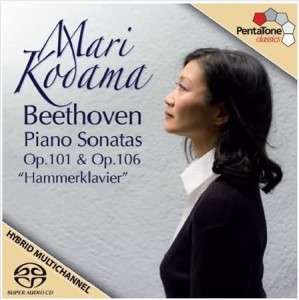Mari Kodama concludes her Beethoven sonata cycle with two of the composer’s most challenging works from both technical and interpretive standpoints. Happily, Op. 101 finds her in top pianistic and musical fettle. Following an eloquent and easily flowing first movement, Kodama navigates the Scherzo’s obsessive march rhythms, tricky balances, and difficult-to-articulate trills with impressive clarity, poise, and drama, and brings similar qualities to the knotty fugal finale.
For all of her proficient finger work in the “Hammerklavier” sonata’s first movement, Kodama tends to round off phrases, play down accents, and soften dynamic extremes. Her smooth and careful dispatch of the Scherzo Trio’s upward F major scales robs this gesture of its climactic impact. At the end of the movement the main theme briefly appears in the remote key of B minor, and by underlining it with an unsubtle ritard Kodama misjudges this effect’s sense of deadpan surprise. In Kodama’s hands the slow movement seems more of an Andante con moto than Beethoven’s Adagio sostenuto, although her nuanced handling of the right hand’s elaborate singing lines saves the day.
In the fourth movement’s opening Largo, Kodama imposes a gratuitous and dramatically ineffective ritard in the brief G-sharp minor contrapuntal outburst, and she begins the gradually accelerating syncopated chords leading into the fugue too quickly. The fugue itself begins in a crisp, characterfully light manner, yet Kodama’s basic tempo slightly decreases over time and her articulation becomes more generalized as the music grows in textural complexity (a tendency with most pianists in this movement, to be fair). In other words, more daring, leonine “Hammerklavier” performances of recent vintage by Georg Friedrich Schenck and Stewart Goodyear hold stronger appeal. No question, however, that Kodama’s outstanding Op. 101 is one of her cycle’s high points, and the sonics (in both multi-channel and conventional stereo playback modes) match the superb consistency distinguishing this series’ eight previous volumes.
































